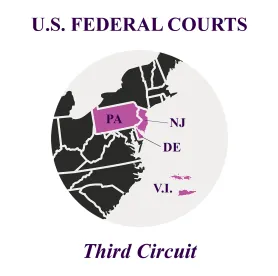On January 31, 2022, the United States Court of Appeals for the Third Circuit held in Doe v. Scalia that once the Occupational Safety and Health Administration (OSHA) has completed enforcement proceedings, an employee may not maintain a lawsuit under the Occupational Safety and Health Act of 1970 (OSH Act).
Background
The OSH Act created OSHA to develop and enforce workplace safety standards. As the Third Circuit noted in Doe v. Scalia, “In general, OSHA, rather than private litigants, is responsible for assuring workplace safety.” Although the OSH Act permits employees to request a workplace inspection, it gives OSHA the final determination as to whether “there are no reasonable grounds to believe that a violation or danger exists.” The OSH Act authorizes OSHA to issue citations to employers for violations of the OSH Act or OSHA regulations, and it establishes “standard ‘enforcement procedures,’ under which employers may contest an OSHA citation.” (Emphasis in the original.)
In addition to standard enforcement procedures, Section 662 of the OSH Act allows OSHA to seek injunctive relief against an employer when it identifies workplace hazards “which could reasonably be expected to cause death or serious physical harm immediately” or before they can be eliminated through OSHA’s standard enforcement procedures. If OSHA “arbitrarily or capriciously fails to seek relief under this section,” employees may “bring an action against the Secretary [of Labor] … to compel the Secretary to seek such an order.”
The plaintiffs in Doe v. Scalia were employees at a Pennsylvania meatpacking plant who claimed that their employer’s allegedly insufficient COVID-19 prevention measures had caused imminent danger (i.e., the employer “forced workers to work shoulder-to-shoulder on its production line”). The employees complained to OSHA. Upon completing its investigation under Section 662, OSHA determined there was no imminent danger and, therefore, did not seek injunctive relief; however, OSHA’s investigation continued under its standard enforcement procedures.
The Lawsuit
On July 22, 2020, the plaintiffs filed a complaint in the U.S. District Court for the Middle District of Pennsylvania against the secretary of labor alleging OSHA failed to take action to address the alleged inadequate COVID-19 measures. OSHA moved to dismiss the complaint, contending the plaintiffs could not prove OSHA had “arbitrarily and capriciously” declined to seek injunctive relief. While the motion to dismiss was pending, OSHA completed its investigation and did not issue a citation. OSHA’s regional administrator affirmed the decision not to issue a citation, noting the determination was “final and not subject to review.”
Because the OSHA inspector did not find any imminent danger or recommend the secretary take action, the district court held that there was “no secretarial decision” to review and the court lacked jurisdiction to hear the employees’ claim.
On appeal, the Third Circuit stated, “The crux of this case concerns the extent to which [Section 662(d) of the OSH Act] gives employees a private right of action to remediate dangers in the workplace … after the Department of Labor has completed enforcement proceedings.” The Third Circuit pointed out the question was a “matter of first impression” for the courts of appeal. Based on the language of the OSH Act and the enforcement scheme the U.S. Congress established in the OSH Act, the Third Circuit affirmed dismissal of the case. The Third Circuit explained:
Employee-driven relief under § 662(d) … is available only during the pendency of OSHA’s standard enforcement proceedings.
…
But the Secretary’s ability to seek an injunctive order against an employer expires upon the termination of OSHA’s “normal enforcement proceedings.” … And as the Secretary cannot fairly be said to “fail[] to seek relief” when the Secretary lacks the very authority to pursue that relief, it follows that § 662(d)’s private right of action likewise expires once OSHA has completed its enforcement proceedings.
This construction also accords with the enforcement scheme Congress established in the OSH Act. … Here, § 662 makes manifest that it is concerned with “imminent dangers” that might exist “pending the outcome of an enforcement proceeding.” This evinces clear congressional intent to establish in § 662 a limited mechanism to remedy imminent dangers that cannot await the conclusion of OSHA’s standard enforcement process.
… What’s more, the broad private right of action that Plaintiffs propose would undermine the OSH Act’s agency-driven enforcement structure …. We conclude, therefore, that the private right embodied in § 662(d) is a narrow one, limited to combating imminent workplace dangers that cannot await the conclusion of OSHA’s enforcement proceedings.
Key Takeaways
Doe v. Scalia is significant because it reinforces OSHA as the arbiter of workplace safety, and it narrowly limits the circumstances in which an employee may file an action in court to seek relief for alleged violations of the OSH Act or OSHA regulations.





 />i
/>i
